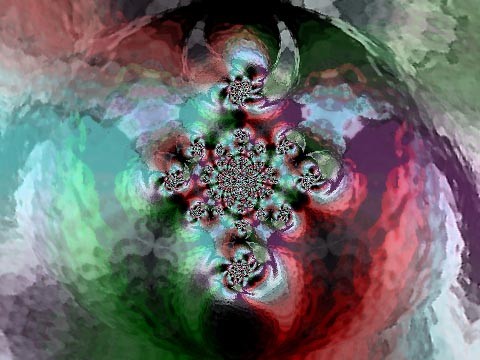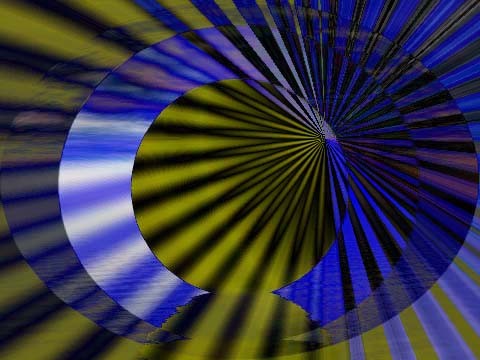| What is Optical Art? Introduction to and History of this Fantastic, Thrilling Art Movement |
| Menu: ** Home ** What is Art? ** Optical Art Page ** Interactive Possibilities: Virtual Communities ** Effects of Technology on Optical Art ** Image Gallery ** Conclusion ** Bibliography ** E-Mail Me! |
"Reality is more than the thing itself. I look always for its super reality. Reality lies in the way you see things." -Pablo Picasso Introduction to Optical Art Optical or "op" art is an abstract movement that involves the phenomena of visual perception (arthistory.com). It was developed in the United States and Europe in the mid 1960s. At the time, artists were interested in the idea of creating movement on a two- dimensional surface by tricking the eye with a series of optical illusions (Virgine, 88). "Optical" refers to "optical illusion" (Atkins, 25). The phenomenon of perception has concerned many artists throughout history, "both as a problem of simple translation and as a scientific principle governing reality and illusion"(Lancaster, 7). Like Dadaism, this art movement was totally different and totally untraditional according to contemporary art. This new movement was considered to be profane, technological, and pro-scientific. It achieved its peak of popularity in the years of 1965 to 1968. Op art covers the areas of colour chemistry, mathematics, optics and kinetics, as well as the study of weaving and hard-edged painting. As we all know, op art paintings are based on tricks of visual perception. Many op artist use rules of perspective to give the illusion of three-dimensional space, they can mix colours to give the impression of light and shadow, and they also use symmetry and repetition to create an illusional effect (ArtCyclopedia.com). Op art contain dynamic yet illusive qualities, which are real one moment, and unreal the next, and which give its patterns the appearance of constant motion. It seems as though the object or artwork itself is lost in time and in space. With optical art, the rules that the eye applies, to make sense of a visual image, are themselves the "subjects" of the artwork. The way in which the eye sees is the greatest challenge offered from op art paintings. (Lancaster, 27) In the mid-20th century, artists such as Josef Albers, Victor Vasarely, and M.C. Escher experimented with optical art. Escher's work, which is not always abstract, also deals extensively with various forms of visual tricks and paradoxes. |
| The term "op" was first used in an article from Time magazine in October, 1964. "Op art" is unique because it appealed to the popular imagination almost before the critics and even the artists themselves were aware of it (Barrett,7). Op art is an art movement, which has represented a new understanding of the aesthetic value of art (Virgine, 89). It requires a large amount of contemplation on behalf of the artist and the viewer. What we see and understand is a result of the way in which the brain interprets information given by the eye. The viewer is encouraged to consider his own relationship and involvement with the art form. In op art, "the spectator is made conscious of the act of perception, the reality of seeing. (Lancaster, 36)" Distinguishing and interpreting the image in any one particular manner is the fascinating challenge offered by op art. "Optical art is a method of painting concerning the interaction between illusion and picture plane, between understanding and seeing. (Lancaster, 28)" The technological world is reflected in op art. Op art can in return be produced by computers. Geometrical patterns can be drawn over the computer using specific sophisticated software. Mathematical relationships, as well as formulaes, can also be implemented using a computer. One can create so many visual relationships in the artwork using the computer and specific design software. |
 |
| Magic Web ClipArt Gallery www.cpsweb.com/opart.htm |
| (c). By Vann-Ly Cheng, 2002. |
| "No stronger evidence of the new level of visual sensibility could be presented than the recent and quite unprecedent wave of painting without colour." -Seitz (Barrett, 38) |
| As we all know, op art introduced black-and-white painting. This typed of painting had introduced a perceptual transformation in the art world. Since the mind's impulses are not entirely dependent on colour, the use of black and white in op art is quite popular. A large number of artists paint without colour. Black and white have replaced colour in some instances. Optical effects are achieved using these two colours, which provide a more dynamic and dramatic effect. They also provide a greater contrast because of their big difference in colour. Our eyes are more sensitive to the light and the dark. Using black and white to produce op paintings provide a clearer definition of the artwork, and can induce interesting perceptual reactions. Another dynamic element of op art is colour. Colour has its own optical potential, however, it can distract and disturb the eye from distinguishing the actual art object (Lancaster, 33). Op artists may use multi-coloured patterns to cause a perceptual change. Some artists may use colours to emphasize shapes, forms or a series of lines. If op artists use colour, they would most likely use bold colours to introduce intense and new spatial relationships (Parola, 11). |
| Op artists "wanted to systematically analyze the phenomena of perception, to make a science of art, to demonstrate that the implications of cognition and communication were not the only things that counted in the work, that the prject of the work is the work of art independent from its realisation." (Virgine, 88) |
| To see the references used for this page, please click here>...... |
| Resulting images of op art can be "mysterisous, irritating and perplexing to our eyes and brains." (Lancaster, 9) |
 |
| Magic Web ClipArt Gallery www.cpsweb.com/opart.htm |
| The Style of Op Art The subject matter of optical paintings is abstract and consists of geometric forms, mechanical patterns, screens, and target effects. Geometric shapes are often the theme of optical art. Optical art uses symmetry and dual symmetry to emphasize the object or subject matter to aid concentration (Parola, 10). The use of patterns is another form of composition employed by the op artist. Patterns are orderly, symmetrical repetition of an image. "Our perceptual reactions are built on a concept of pattern. (Parola, 78)" According to the op artist Rene Parola, it causes "multiplicity of simplicity" by multiplying the objects of perception, and it also causes complex visual relationships. Some artists may produce implied movement into space by varying the density of the pattern. Combinations of flat patterns such as circles and ellipses also can create limited movement. According to Parola, op artists may also use different perspectives to create the illusion of infinite space by linear perspective. Different perspectives create the illusion of movement in space, for example reversible images create the effect of movement. Moreover, the use of angles plays a huge role in op art. Different angles help create twisted cord illusions, which are illusions that use oblique or acute angles. This type of illusion uses simple geometric shapes that conform to such angles. In addition to the use of patterns, moire [pronounced as moray] patterns are used as well. Moire patterns occur when two sets of lines are superimposed (overlapped) at an angle of less than thirty degrees (Parola, 55). They can be made with any pattern of geometric shapes, ex. circles, squares and triangles. The most effective and dramatic moires are the result of line patterns (Parola, 55). "Op art uses the moire pattern as a focus for art. (Parola, 55)" Parola believes that we are surrounded by moires in everyday life; they occur in the overlapping of picket fences, baskets and sheer nylon curtains. |
| "Op must qualify as art by definition of purpose, understanding of method and need, quality of technique, and interpretation of application." (Rene Parola, 13) |
| Check this image out! You will get dizzy if you stare at it for a long time!! |
 |
| History of Op Art "History exists by virtue of the present." (John Lancaster) The history of op art can be first dated back to the year 700 AD. One of the finest examples of early Christian illuminated manuscripts, the Lindisfarne Gospel, shows the use of an interwoven pattern of lines which cross over and under one another in a complicated way. This was not considered op art back then, however, if we use our knowledge of what op art is, we can see that there are certain works of art, dating back in history, that relate to op art. History exists only in the present. "The ways in which we interpret and understand events of the past are bound to be controlled by our present way of thinking, our own vocabulary of experience. (Lancaster, 97)" Prior to the Renaissance, the concept of op art was impossible. A number of artists such as: Masaccio (1401-1428), Piero Della Francesca (1410/20- 1492), Uccello (1398-1475), and others established the basic laws of illusionism. "The Renaissance was the genesis of a modern way of thinking. (Lancaster, 99)" It had discovered the mathematics and geometry of perspective and illusion. The first instances of the camera came into existence as well. The Mannerism that followed the High Renaissance saw the early beginnings of op art forms. A change in subject matter also started to occur prior to the Renaissance. Sensationalism, a philosophy that believes reality to exist only through the evidence of the senses, began to influence the arts, and the change in subject matter went underway. By the eighteenth century, art was in a position to further its investigation into how people see. This was the beginning of perception. "The modern idea of op art is usually thought of in terms of abstract painting. (Lancaster, 102)" Abstract art refers to a painting or any work of art having no immediate resemblance to anything seen in the normal way. The goal of op art is to not just solely produce optical illusions or optical effects. Rather, op art involves the use of certain optical effects such as the use of black and white, colour, light to create movement in time and in space, surrealism, multiplicity, patterns, geometrical shapes, symmetry and so much more. This creative art movement has infinite possibilities. |
| "Op painting has one advantage over every other kind. It gives everyone the same sensation, regardless of eye and experience. To the Op artist we are all equal." -Robert Melville |